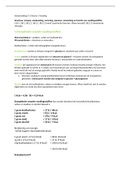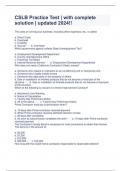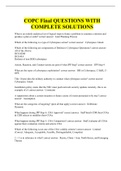HARDWARE -P1
KDG | 2021
,Inhoudsopgave
1. Taltelsels ..................................................................................................................................................... 3
1.1 Getalvoorstellingen....................................................................................................................................... 3
1.1.1 Het decimaal talstelsel .......................................................................................................................... 3
1.1.2 Het binaire talstelsel ............................................................................................................................. 3
1.1.3 Het hexadecimaal talstelsel .................................................................................................................. 4
1.1.4 Het octale talstelsel .............................................................................................................................. 4
1.1.5 Willekeurige talstelsels ......................................................................................................................... 4
1.2 Veranderen van talstelsel ............................................................................................................................. 4
1.2.1 Van G-tallig naar decimaal .................................................................................................................... 4
1.2.2 Van decimaal naar G-tallig .................................................................................................................... 5
1.2.3 Van binair naar hexadecimaal en omgekeerd ...................................................................................... 5
1.3 Negatieve getallen ........................................................................................................................................ 6
1.3.1 Sign-bit .................................................................................................................................................. 6
1.3.2 1-complement....................................................................................................................................... 7
1.3.3 2-complement....................................................................................................................................... 8
1.3.4 Offset .................................................................................................................................................... 9
1.4 Het binaire talstelsel in de informatica ......................................................................................................... 9
1.4.1 Datatypes in Java ................................................................................................................................ 10
1.4.2 Getallen omzetten met Java ............................................................................................................... 10
1.4.3 Literals in Java ..................................................................................................................................... 10
1.4.4 BigIntiger ............................................................................................................................................. 10
1.4.5 Grootheden......................................................................................................................................... 10
1.4.6 MSB en LSB ......................................................................................................................................... 11
1.4.7 Little endian en big endian.................................................................................................................. 12
1.5 Karaktersets ................................................................................................................................................ 12
1.5.1 Oude systemen ................................................................................................................................... 13
1.5.2 ASCII .................................................................................................................................................... 13
1.5.3 Unicode: code-points .......................................................................................................................... 13
1.5.4 Unicode encodering ............................................................................................................................ 14
1.5.5 Glyphs ................................................................................................................................................. 15
1.6 Rekenen met binaire getallen ..................................................................................................................... 16
1.6.1 Optellen en aftrekken ......................................................................................................................... 16
1.6.2 Vermenigvuldigen ............................................................................................................................... 17
2. Komagetallen ............................................................................................................................................ 21
2.1 Kommagetallen in het binaire talstelsen .................................................................................................... 21
2.2 Omzetten van decimaal naar binair ........................................................................................................... 21
2.2.1 Iteratieve methode ............................................................................................................................. 21
2.2.2 Directe methode ................................................................................................................................. 22
2.3 Fixed point .................................................................................................................................................. 23
2.4 Floating point.............................................................................................................................................. 24
1
, 2.5 Floating point in de computer: IEEE 754 ..................................................................................................... 25
2.5.1 De waarde van een IEEE 754 getal ...................................................................................................... 25
2.5.2 Van decimale notatie naar IEEE 754 ................................................................................................... 26
2.5.3 Denormalisatie .................................................................................................................................... 26
2.6 Bereik en fout.............................................................................................................................................. 27
2.6.1 Bereik .................................................................................................................................................. 27
2.6.2 Fout ..................................................................................................................................................... 29
2.7 Rekenen met floating point getallen .......................................................................................................... 30
2.7.1 Optellen en aftrekken ......................................................................................................................... 30
2.7.2 Vermenigvuldigen ............................................................................................................................... 30
2.7.3 Eigenschappen .................................................................................................................................... 31
2.8 kommagetallen in Java ............................................................................................................................... 31
3. Logische schakelingen ............................................................................................................................... 32
3.1 Definitie ...................................................................................................................................................... 32
3.2 Eenvoudige logische schakelingen .............................................................................................................. 34
3.2.1 De NOT poort ...................................................................................................................................... 34
3.2.2 De AND poort ...................................................................................................................................... 34
3.2.3 De OR poort ........................................................................................................................................ 34
3.2.4 De XOR poort ...................................................................................................................................... 35
3.2.5 De NAND poort ................................................................................................................................... 35
3.2.6 De NOR poort ...................................................................................................................................... 35
3.2.7 De XNOR poort.................................................................................................................................... 36
3.3 Implementatie van een logische schakeling ............................................................................................... 36
3.3.1 De relais .............................................................................................................................................. 36
3.3.2 Transitors ............................................................................................................................................ 37
3.3.3 TTL integrated circuits......................................................................................................................... 38
3.3.4 Programmeren .................................................................................................................................... 38
4. Booleaanse algebra ................................................................................................................................... 39
4.1 Definitie ...................................................................................................................................................... 39
4.3 De wetten van De Morgan .......................................................................................................................... 40
4.4 Vereenvoudigen van logische schakelingen................................................................................................ 40
4.5 Omzetten naar NAND poorten ................................................................................................................... 41
4.6 Tabellen omzetten naar formules ............................................................................................................... 42
4.6.1 De normaalvorm ................................................................................................................................. 42
4.6.2 Programmmable logic arrays (PLA) ..................................................................................................... 43
4.6.3 Karnaugh kaarten................................................................................................................................ 44
4.6.4 Don’t care toestanden ........................................................................................................................ 45
2
, 1. Taltelsels
1.1 Getalvoorstellingen
We zijn zo gewoon om getallen te lezen en schrijven dat niemand nog stil staat bij de manier
waarop dit gebeurd. Een getal wordt altijd voorgesteld door een reeks symbolen. Ons
syteem is niet het enige: vroeger werden er vele andere systemen gebruikt: streepjes,
symbolen,…
1.1.1 Het decimaal talstelsel
Het grootste verschil tussen de voostelling van getallen bij de Romeinen en ons, is dat bij ons
de plaats van een symbool belangrijk is. Bv bij 44 heeft de eerste 4 een andere betekenis dan
de tweede 4. Een ander verschil is dat wij een nul nodig hebben om alle getallen voor te
kunnen stellen. Voordeel: ook mogelijk negatieve getallen en kommagetallen voor te stellen.
Waarde positief geheel decimaal getal:
a4a3a2a1a0= a4⋅10.000 + a3⋅1.000 + a2⋅100 + a1⋅10 + a0 à We spreken dus van
eenheden, tientallen,
honderdtallen, duizendtallen,…
à telt zoals een kilometer teller
[101] à gewichten aanhangen
100 10 1
1.1.2 Het binaire talstelsel
Een compiler gebruikt elektrische signalen. Als deze met het decimale talstelsel zou moeten
kunnen werken: 10 verschillende signalen à veel fouten.
à enkel 0 en 1 (= bv 0 en 5 volt)
Aangezien maar 2 cijfers: getallen anders voorstellen. Zelfde wijze als decimaal, maar 10
vervangen door 2: eenheden, tweetallen, viertallen, achttallen,… + telt ook als km teller
a4a3a2a1a0 = a4⋅16 + a3⋅8 + a2⋅4 + a1⋅2 + a0
[101] à gewichten aanhangen
4 2 1
3
KDG | 2021
,Inhoudsopgave
1. Taltelsels ..................................................................................................................................................... 3
1.1 Getalvoorstellingen....................................................................................................................................... 3
1.1.1 Het decimaal talstelsel .......................................................................................................................... 3
1.1.2 Het binaire talstelsel ............................................................................................................................. 3
1.1.3 Het hexadecimaal talstelsel .................................................................................................................. 4
1.1.4 Het octale talstelsel .............................................................................................................................. 4
1.1.5 Willekeurige talstelsels ......................................................................................................................... 4
1.2 Veranderen van talstelsel ............................................................................................................................. 4
1.2.1 Van G-tallig naar decimaal .................................................................................................................... 4
1.2.2 Van decimaal naar G-tallig .................................................................................................................... 5
1.2.3 Van binair naar hexadecimaal en omgekeerd ...................................................................................... 5
1.3 Negatieve getallen ........................................................................................................................................ 6
1.3.1 Sign-bit .................................................................................................................................................. 6
1.3.2 1-complement....................................................................................................................................... 7
1.3.3 2-complement....................................................................................................................................... 8
1.3.4 Offset .................................................................................................................................................... 9
1.4 Het binaire talstelsel in de informatica ......................................................................................................... 9
1.4.1 Datatypes in Java ................................................................................................................................ 10
1.4.2 Getallen omzetten met Java ............................................................................................................... 10
1.4.3 Literals in Java ..................................................................................................................................... 10
1.4.4 BigIntiger ............................................................................................................................................. 10
1.4.5 Grootheden......................................................................................................................................... 10
1.4.6 MSB en LSB ......................................................................................................................................... 11
1.4.7 Little endian en big endian.................................................................................................................. 12
1.5 Karaktersets ................................................................................................................................................ 12
1.5.1 Oude systemen ................................................................................................................................... 13
1.5.2 ASCII .................................................................................................................................................... 13
1.5.3 Unicode: code-points .......................................................................................................................... 13
1.5.4 Unicode encodering ............................................................................................................................ 14
1.5.5 Glyphs ................................................................................................................................................. 15
1.6 Rekenen met binaire getallen ..................................................................................................................... 16
1.6.1 Optellen en aftrekken ......................................................................................................................... 16
1.6.2 Vermenigvuldigen ............................................................................................................................... 17
2. Komagetallen ............................................................................................................................................ 21
2.1 Kommagetallen in het binaire talstelsen .................................................................................................... 21
2.2 Omzetten van decimaal naar binair ........................................................................................................... 21
2.2.1 Iteratieve methode ............................................................................................................................. 21
2.2.2 Directe methode ................................................................................................................................. 22
2.3 Fixed point .................................................................................................................................................. 23
2.4 Floating point.............................................................................................................................................. 24
1
, 2.5 Floating point in de computer: IEEE 754 ..................................................................................................... 25
2.5.1 De waarde van een IEEE 754 getal ...................................................................................................... 25
2.5.2 Van decimale notatie naar IEEE 754 ................................................................................................... 26
2.5.3 Denormalisatie .................................................................................................................................... 26
2.6 Bereik en fout.............................................................................................................................................. 27
2.6.1 Bereik .................................................................................................................................................. 27
2.6.2 Fout ..................................................................................................................................................... 29
2.7 Rekenen met floating point getallen .......................................................................................................... 30
2.7.1 Optellen en aftrekken ......................................................................................................................... 30
2.7.2 Vermenigvuldigen ............................................................................................................................... 30
2.7.3 Eigenschappen .................................................................................................................................... 31
2.8 kommagetallen in Java ............................................................................................................................... 31
3. Logische schakelingen ............................................................................................................................... 32
3.1 Definitie ...................................................................................................................................................... 32
3.2 Eenvoudige logische schakelingen .............................................................................................................. 34
3.2.1 De NOT poort ...................................................................................................................................... 34
3.2.2 De AND poort ...................................................................................................................................... 34
3.2.3 De OR poort ........................................................................................................................................ 34
3.2.4 De XOR poort ...................................................................................................................................... 35
3.2.5 De NAND poort ................................................................................................................................... 35
3.2.6 De NOR poort ...................................................................................................................................... 35
3.2.7 De XNOR poort.................................................................................................................................... 36
3.3 Implementatie van een logische schakeling ............................................................................................... 36
3.3.1 De relais .............................................................................................................................................. 36
3.3.2 Transitors ............................................................................................................................................ 37
3.3.3 TTL integrated circuits......................................................................................................................... 38
3.3.4 Programmeren .................................................................................................................................... 38
4. Booleaanse algebra ................................................................................................................................... 39
4.1 Definitie ...................................................................................................................................................... 39
4.3 De wetten van De Morgan .......................................................................................................................... 40
4.4 Vereenvoudigen van logische schakelingen................................................................................................ 40
4.5 Omzetten naar NAND poorten ................................................................................................................... 41
4.6 Tabellen omzetten naar formules ............................................................................................................... 42
4.6.1 De normaalvorm ................................................................................................................................. 42
4.6.2 Programmmable logic arrays (PLA) ..................................................................................................... 43
4.6.3 Karnaugh kaarten................................................................................................................................ 44
4.6.4 Don’t care toestanden ........................................................................................................................ 45
2
, 1. Taltelsels
1.1 Getalvoorstellingen
We zijn zo gewoon om getallen te lezen en schrijven dat niemand nog stil staat bij de manier
waarop dit gebeurd. Een getal wordt altijd voorgesteld door een reeks symbolen. Ons
syteem is niet het enige: vroeger werden er vele andere systemen gebruikt: streepjes,
symbolen,…
1.1.1 Het decimaal talstelsel
Het grootste verschil tussen de voostelling van getallen bij de Romeinen en ons, is dat bij ons
de plaats van een symbool belangrijk is. Bv bij 44 heeft de eerste 4 een andere betekenis dan
de tweede 4. Een ander verschil is dat wij een nul nodig hebben om alle getallen voor te
kunnen stellen. Voordeel: ook mogelijk negatieve getallen en kommagetallen voor te stellen.
Waarde positief geheel decimaal getal:
a4a3a2a1a0= a4⋅10.000 + a3⋅1.000 + a2⋅100 + a1⋅10 + a0 à We spreken dus van
eenheden, tientallen,
honderdtallen, duizendtallen,…
à telt zoals een kilometer teller
[101] à gewichten aanhangen
100 10 1
1.1.2 Het binaire talstelsel
Een compiler gebruikt elektrische signalen. Als deze met het decimale talstelsel zou moeten
kunnen werken: 10 verschillende signalen à veel fouten.
à enkel 0 en 1 (= bv 0 en 5 volt)
Aangezien maar 2 cijfers: getallen anders voorstellen. Zelfde wijze als decimaal, maar 10
vervangen door 2: eenheden, tweetallen, viertallen, achttallen,… + telt ook als km teller
a4a3a2a1a0 = a4⋅16 + a3⋅8 + a2⋅4 + a1⋅2 + a0
[101] à gewichten aanhangen
4 2 1
3











